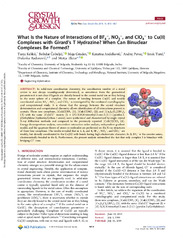Приказ основних података о документу
What Is the Nature of Interactions of BF4–, NO3–, and ClO4– to Cu(II) Complexes with Girard’s T Hydrazine? When Can Binuclear Complexes Be Formed?
| dc.creator | Keškić, Tanja | |
| dc.creator | Čobeljić, Božidar | |
| dc.creator | Gruden-Pavlović, Maja | |
| dc.creator | Anđelković, Katarina | |
| dc.creator | Pevec, Andrej | |
| dc.creator | Turel, Iztok | |
| dc.creator | Radanović, Dušanka | |
| dc.creator | Zlatar, Matija | |
| dc.date.accessioned | 2023-11-09T10:19:46Z | |
| dc.date.available | 2023-11-09T10:19:46Z | |
| dc.date.issued | 2019-07-15 | |
| dc.identifier.uri | http://r.istocar.bg.ac.rs/handle/123456789/945 | |
| dc.description.abstract | In solid-state coordination chemistry, the coordination number of a metal center is not always unambiguously determined, as sometimes from the geometrical parameters it is not clear if ligands are directly bound to the central metal ion or they belong to the outer sphere of a complex. The nature of bonding between Cu(II) and weakly coordinated anions BF4–, NO3–, and ClO4– is investigated by the combined crystallographic and computational study. It is shown that the synergy between the crystal structure determination and computational chemistry allows identification of all interactions present in crystals. Three new complexes, [CuLCl]BF4 (1), [CuLCl]NO3 (2), and [Cu2L2Cl2](BF4)2 (3) with the same [CuLCl]+ moiety (L = (E)-N,N,N-trimethyl-2-oxo-2-(2-(1-(pyridin-2-yl)ethylidene)hydrazinyl)ethan-1-amin), were synthesized and characterized by single crystal X-ray diffraction methods and compared to the previously reported [CuLCl]ClO4 (4). Energy decomposition analysis, noncovalent interaction index analysis, independent gradient model, and the quantum theory of atoms in molecules are performed on the X-ray structures of these four complexes. The results revealed that in 1, 2, and 4, BF4–, NO3–, and ClO4– are weakly, but directly coordinated to the Cu(II) with bonds having high electrostatic character. In 3, BF4– is the counter-anion, electrostatically bonded to the L. Furthermore, the present analysis rationalized the fact that only complex 3 is binuclear with bridging Cl– ions. | sr |
| dc.language.iso | en | sr |
| dc.publisher | American Chemical Society | sr |
| dc.relation | info:eu-repo/grantAgreement/MESTD/Basic Research (BR or ON)/172035/RS// | sr |
| dc.relation | info:eu-repo/grantAgreement/MESTD/Basic Research (BR or ON)/172055/RS// | sr |
| dc.rights | openAccess | sr |
| dc.rights.uri | https://creativecommons.org/licenses/by/4.0/ | |
| dc.source | Crystal Growth & Design | sr |
| dc.subject | Anions | sr |
| dc.subject | Crystal structure | sr |
| dc.subject | Crystals | sr |
| dc.subject | Ligands | sr |
| dc.subject | Mathematical methods | sr |
| dc.title | What Is the Nature of Interactions of BF4–, NO3–, and ClO4– to Cu(II) Complexes with Girard’s T Hydrazine? When Can Binuclear Complexes Be Formed? | sr |
| dc.type | article | sr |
| dc.rights.license | BY | sr |
| dc.citation.volume | 19 | |
| dc.citation.issue | 8 | |
| dc.citation.spage | 4810 | |
| dc.citation.epage | 4821 | |
| dc.identifier.doi | https://doi.org/10.1021/acs.cgd.9b00760 | |
| dc.identifier.fulltext | http://r.istocar.bg.ac.rs/bitstream/id/4490/bitstream_4490.pdf | |
| dc.type.version | publishedVersion | sr |


